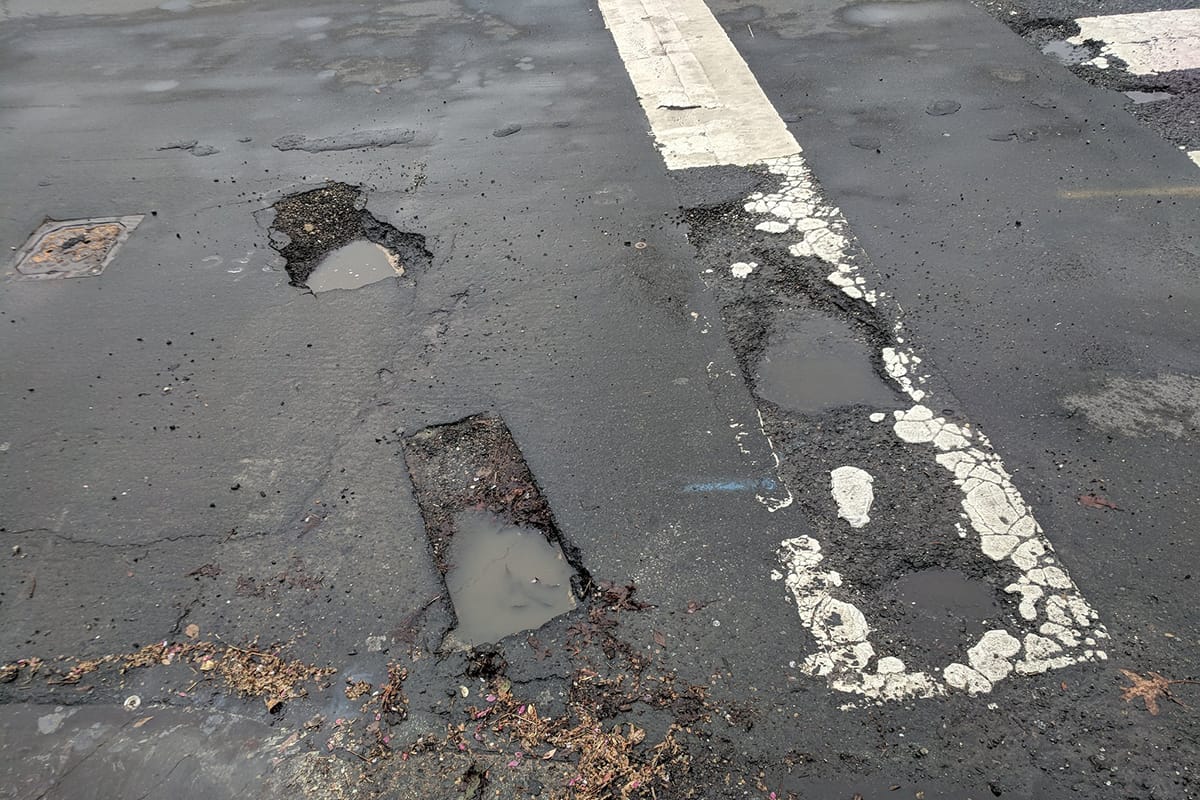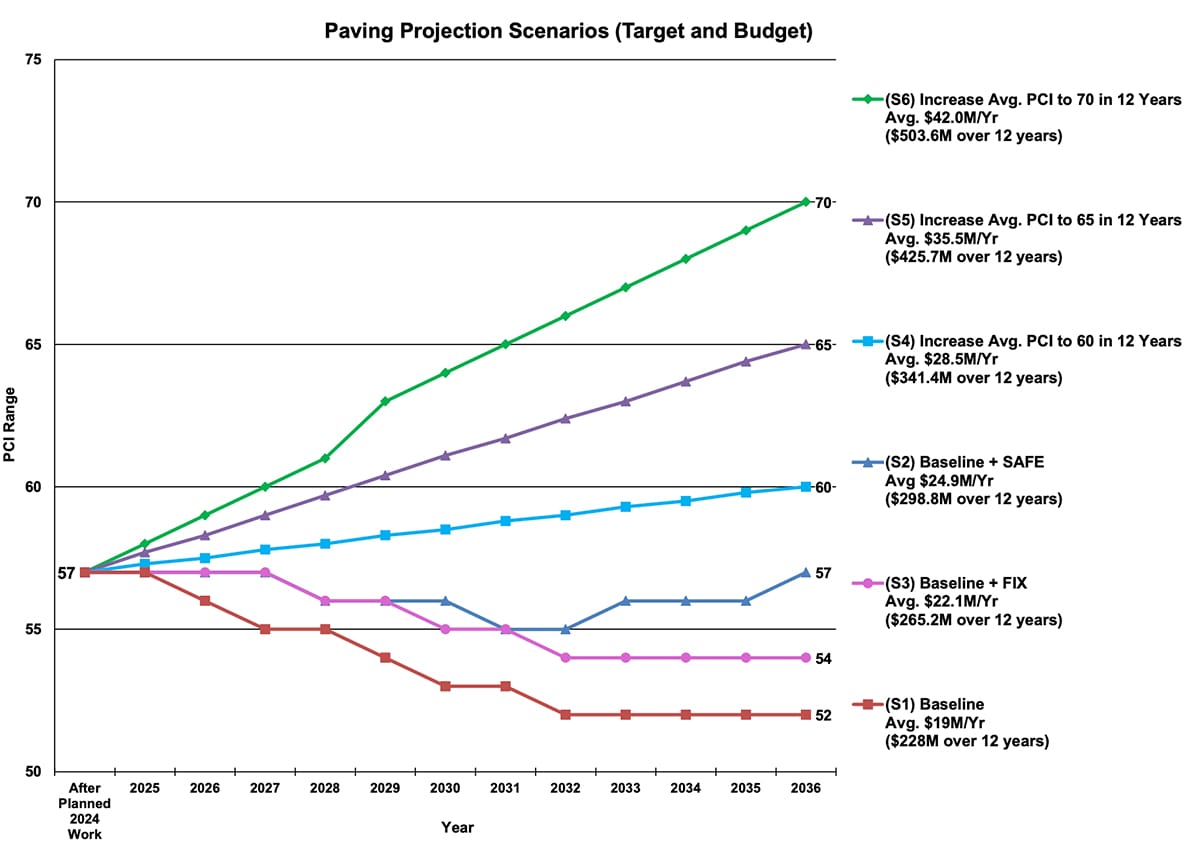Berkeley street ballot measures EE and FF: How do they differ?
Residents can vote for both measures. If each gets more than 50%, the one with more votes will prevail.

The buzz about Berkeley's dueling street improvement ballot measures is in full force, with Election Day coming and mail-in voting underway.
From social media to neighborhood canvassing, proponents of each measure are ramping up efforts to make their case.
If you're confused by the measures, which at first glance may seem similar, you're not alone. It is confusing.
Both measures require the city to continue funding street work at around the same level it does today.
But there are some distinct differences between measures EE (Fix the Streets & Sidewalks) and FF (Safe Streets), mainly in the details of what they will or won't fund, if approved, and by how much.
There are also differences in cost to property owners, and how long the tax would last.
In general, both ballot measures ask voters to approve a new property tax for street and pedestrian improvements, including street paving, sidewalk repair, roadway safety enhancements for bikers and walkers, and "green" technology for filtering storm runoff and cleaning streets. Both require citizen oversight.
Measure FF would cost property owners more than EE and, in doing so, raise more money. The measure also targets a wider range of projects, especially for bicycle safety and infrastructure, following the city's existing transportation plans.
Measure FF would also extend the tax and funding for two more years.
Measure EE more narrowly funds street safety, citing what it calls incomplete project evaluations in the city's transportation plans.
Each measure needs a simple majority of more than 50% to pass.
Residents can vote on both measures. If each one meets the threshold, the one with the most votes wins.
2024 Berkeley elections: Measure FF
Measure FF is set to fund street, sidewalk and pedestrian path repair, repaving and reconstruction along with safety improvements and environmental infrastructure.
Property owners would initially pay $0.17 per residential square foot (about $297 per year for the typical house) and $0.25 per square foot on other types of property, such as commercial. The rates may increase annually for inflation.
Total pot: About $15 million annually for 14 years
2024 Berkeley elections: Measure EE
Measure EE would fund street and sidewalk repair, repaving and reconstruction, pedestrian safety projects, traffic-calming measures on bicycle boulevards and green infrastructure.
Property owners would pay $0.13 per residential square foot ($227 per year for the typical house), which may be increased annually for inflation.
Total pot: About $10.5 million annually for 12 years
Berkeley ballot measures EE and FF: Funding pies sliced differently
Both Berkeley ballot measures spell out what percentage of the money raised could be spent on what type of work. But the project categories differ.
Here's a breakdown.
Measure FF (Safe Streets)
- Streets: 45% or about $6 million
- Safety improvements: 30% or $4 million
- Sidewalks and pedestrian paths: 15% or about $2 million
- Environmental enhancements and fees: 10% or $1.3 million
Measure EE (Fix the Streets & Sidewalks)
- Street repair, repaving and reconstruction: 37.5% or $3.8 million
- Sidewalk and pathway repair: 35% or $3.6 million
- High-priority pedestrian safety: 13.5% or $1.4 million
- Traffic calming on bicycle boulevards: 7% or nearly $600,000
- Green infrastructure, environmental enhancements: 7% or nearly $600,000
What prompted the street improvement measures?
Street maintenance in Berkeley, from pothole repairs to repaving, has been chronically underfunded.
City estimates place the deferred street maintenance budget at around $267 million.
Either tax, if approved, would augment what the city already spends on this type of work, which averages out to about $15 million a year. That money comes from the annual operating budget, existing taxes and grants.
According to a July staff analysis, both street improvement measures are "well-structured and would benefit pavement/sidewalk maintenance in the City."
But the analysis also found that neither measure would raise enough "to achieve the desired and stipulated pavement conditions index rating (PCI) of 70 out of 100."
Both measures would, instead, help maintain current conditions and prevent further decay.
In public works speak, PCI means "pavement conditions index," which ranges from 0 to 100 (for new roads) and is based on standards set by the Metropolitan Transportation Commission (MTC), a Bay Area-wide transportation planning agency.
In 2023, according to a city report, the PCI of Berkeley streets ranged from around 53 to 64, which the MTC considers in the "at risk" to "fair" range.
The city's average street PCI is around 55.
The city's eventual goal of 70 PCI is at the MTC's low end of good.

While neither new tax, when added to the city's ongoing street maintenance budget, is enough to get to 70 PCI, Measure FF comes a little closer, according to the staff analysis.
Over a 12-year period, Measure FF funding plus the city's existing budget would get Berkeley streets to a PCI of 57.
Measure EE funding over that period would essentially maintain a PCI of 55, dropping to 54 in later years.
Without either tax, street conditions could decline. But the city will need to continue pursuing additional funding such as grants to move streets to the "good" range.
Measures differ in approach to biking
One of the most significant distinctions between the measures is their approach to improving bicycle travel.
Under a general category of "safety improvements," Measure FF would allocate 30% of the tax pie, or around $4 million yearly, for a variety of possible projects, from enhanced street lighting and crosswalks (such as bulb-outs, raised crossings, beacons) to expanding bicycle lanes including what's sometimes called cycle tracks, lanes that are physically separated from the roadway.
Measure FF makes an exception, however, for the Hopkins Street shopping stretch, from McGee Avenue to Gilman Street, saying it can't be used for this.
Measure FF highlights the city's Vision 2050 Framework, a planning initiative that calls for sustainable and resilient infrastructure, and Vision Zero, which calls for eliminating traffic deaths and severe injuries by 2028, and puts priority on work identified in the city's 2020 Pedestrian Plan, 2017 Bicycle Master Plan and Safe Routes to School program.
By comparison, Measure EE would allocate 7% of the pot, or $716,000, to improving the city's existing bicycle boulevards — including calming measures such as raised crossings.
Measure EE says the tax should be used "primarily" for improving existing infrastructure, rather than new projects, arguing that the city has not completed the transportation evaluations called for in its bike plan and complete streets policy.
Measure EE also allocates 13.5%, or around $1,340,000 a year, to "high priority pedestrian safety" projects identified in the city's Pedestrian Plan.
In its July staff report, the city said both measures would help advance the city's Vision Zero Action Plan goal of eliminating traffic deaths and severe injuries, but that FF "is estimated to provide more funding for these efforts, specifically stating that all safety improvements funded through it must be consistent with City adopted plans: Vision Zero Action Plan, Pedestrian Plan, Bicycle Plan, Complete Streets Policy."
In its first year, Measure FF would add about $4.5 million for street safety improvements.
By comparison, Measure EE would add around $2.1 million in that period: about $1.4 million for pedestrian safety and $716,000 for existing bicycle boulevards.
Both measures also fund sidewalk and pathway repair, which the city estimates is backlogged to the tune of $3.6 million a year.
Measure EE allocates around $3 million a year for the work, compared to about $2 million annually under FF.
Hopkins Street in the background
Both citizen-driven street measures hearken back to the city's defeated 2022 Measure L, a $650 million bond for housing, streets and transportation.
Berkeleyans for Better Planning, which backs Measure EE, strongly opposed Measure L while backers of Measure FF largely supported it.
Today's ballot measures are, in part, an attempt to try again with one piece of Measure L's ambitious package: streets and sidewalks.
Berkeley's Hopkins Street bike lane controversy factors into both measures.
Last year, the city scrapped plans to add bike lanes on Hopkins after a highly contentious multi-year planning process. One of the main reasons the city said it called off the plan was because the fire department didn't sign off.
The Hopkins project pitted bike safety advocates against people concerned about reduced street parking in a popular neighborhood shopping district in northwest Berkeley.
Berkeleyans for Better Planning joined with Friends of Hopkins Street to oppose the Hopkins bike lanes.
Nancy Rader, a member of the group and a Measure EE supporter, said: "The Hopkins cycle track was the desire of a select group trying to impose its will on a neighborhood… That's why we specifically disallowed any money raised by EE to be spent on cycle tracks."
Rader added: "And that's why we require that we measure the results of new street infrastructure projects. Before the city opts to install more cycle tracks, we need to know whether they (a) are safe, and (b) increase ridership."
Ben Gerhardstein, of Walk Bike Berkeley, which backs Measure FF, said the goal of his group was to develop a new tax measure with those who opposed the Hopkins bike lanes.
Both said they were unable to reach a compromise. A main sticking point was cycle tracks.
"One way we sought to compromise and avoid having two measures was to not allow Measure FF funds to be used for cycle tracks on that controversial segment of Hopkins Avenue," Gerhardstein said. "Despite this, Measure EE's proponents later submitted a measure that entirely disqualifies cycle tracks (aka protected bike lanes)" from city funding.
Gerhardstein dismissed the Measure EE requirement for further evaluations as "a classic delay strategy" and said the city already emphasizes data-driven analyses and solutions — as would Measure FF.
"The key difference is that EE requires studies to be done each year before any money is allocated," he said, "even if the study was just completed last year, and even if the City has adopted paving and safety plans we'd like to implement based on past data. It's an extreme and burdensome approach that will only serve to delay much-needed safety improvements."
So far, Measure FF has garnered wide support, with endorsements from, among others, the Berkeley Fire Fighters Association, Berkeley Federation of Teachers, Sierra Club, League of Women Voters of Berkeley Albany and Emeryville, the Alameda County Democratic Party, Assemblymember Buffy Wicks, the city auditor, Mayor Jesse Arreguín, and all the current City Council members except Sophie Hahn.
Measure EE is endorsed by the Green Party of Alameda County, the League of Women Voters of Berkeley Albany and Emeryville (which also supports FF), and the Bridge Association of Realtors.
Read more about your Berkeley ballot

Correction: Measure EE provides funding for existing bike boulevards, not bike lanes. The story has been updated. We also clarified Berkeleyans for Better Planning’s stance on the Hopkins cycle track.





